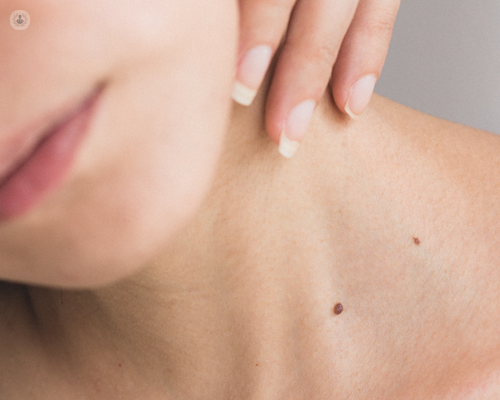Skin cancer of the head and neck
Autore:Skin cancer, specifically on the head and neck, can come in many different forms; some you may not be aware of. Despite this, it’s still important to recognise their severity and by staying informed, it gives people the confidence to act if they have any doubts or queries.
In light of this, award-winning consultant oral and maxillofacial, and head and neck surgeon Professor Kavin Andi has written an informative article about the topic. He highlights the various types of head and neck cancer, signs to look out for and how they are treated.

What is skin cancer of the head and neck?
Skin cancers of the head and neck incorporate a wide range of different cancer types. The major skin cancers are:
Other rare types such as Merkel cell carcinoma, sebaceous gland carcinoma and atypical fibroxanthoma may also present in the head and neck clinic.
What are skin cancer of the head and neck symptoms?
Basal cell carcinoma
These occur in sun-exposed areas such as your face, neck and ears. You may have noticed a pearly or waxy bump that scabs or bleeds easily, which heals and then returns. There may be associated itching in the area and/or more prominent blood vessels.
Squamous cell carcinoma
Again, these occur in sun-exposed areas however, people with darker skin are more likely to develop aquamous cell carcinomas in areas which are not often exposed to the sun. They may appear as a firm red nodule or a flat lesion with scaly, crusted surface.
Melanoma
These can develop anywhere in the body and may develop in an existing mole. The skin doesn't necessarily need to have been exposed to the sun. People of any skin tone can be affected by melanoma and in people with darker skin tones, it has a tendency to occur on the soles of the feet and palms of the hands, as well as under the toenails or fingernails.
You may notice:
- A mole which has changed in size shape or colour
- A brownish spot with darker spots within it
- A small lesion with irregular borders with portions which appear red, white, pink or blue-black
- Dark lesions on the soles of your feet, under your palms or under the fingernails/toenails
Can these sores disappear and then regrow, or do they remain until a doctor removes them?
Some lesions may appear to disappear as the body tries to heal but importantly, they tend to come back in the same area. All suspected skin cancers of the head and neck should be reviewed by a maxillofacial surgeon to determine whether a biopsy will be required to give a definitive diagnosis.
What are the risk factors?
UV radiation exposure is by far the most important risk factor. However, patients who have had localised immunosuppression due to radiotherapy or chemotherapeutic drugs are also at increased risk.
How is skin cancer of the head and neck treated?
Surgical removal with clear margins is the mainstay of treatment. On the face, this will often require reconstruction with local skin flaps to provide the best results for cosmesis. Occasionally, depending on the size and position of the defect skin, a local skin graft or artificial skin substitutes can be used to restore the defect.
For very large areas which require extensive removal and reconstruction, microvascular flaps (e.g radial forearm free flap, antero-lateral thigh flap, latissimus dorsi free flap) represent the gold standard of care.
For an expert consultation regarding skin cancer of the head and neck, Professor Andi is a go-to specialist. Visit his Top Doctors profile here to arrange a visit.


